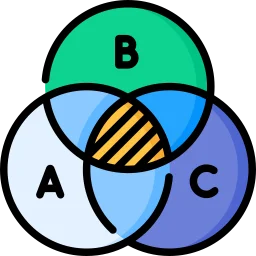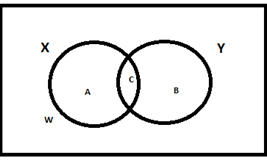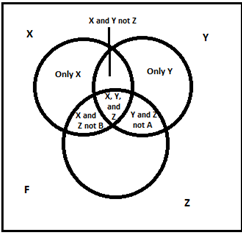Quants Menu
- HCF and LCM
- Number System
- Number Decimals & Fractions
- Surds and Indices
- Divisibility
- Ages
- LCM
- HCF
- Inverse
- Speed Time and Distance
- Work and Time
- Boats and Streams
- Pipes and Cisterns
- Averages
- Allegations and Mixtures
- Ratio and Proportions
- Simple & Compound Interest
- Simple Interest
- Compound Interest
- Percentages
- Profit & Loss
- Successive Discount 1
- Successive Discount 2
- AP GP HP
- Arithmetic Progressions
- Geometric Progressions
- Harmonic Progressions
- Probability
- Permutation & Combination
- Combination
- Circular Permutation
- Geometry
- Heights and Distances
- Perimeter Area and Volume
- Coordinate Geometry
- Venn Diagrams
- Set Theory
- Algebra
- Linear Equations
- Quadratic Equations
- Logarithms
- Clocks
- Calendars
- Clocks and Calendars
- Finding remainder of large powers
PREPINSTA PRIME
Venn Diagrams Questions and Answers
Questions on Venn Diagrams
A diagram demonstrating the mathematical or logical arrangements visually in the form of circles or closed curves inside an enfolding rectangle and the common essentials of the groups being signified by intersections of the circles is known as the Venn diagram. On this page we will discuss questions related to Venn Diagrams
Venn diagram
Usually, it is used to represent the set interactions. It uses overlying circles or more figures to demonstrate the rational relationships among two or more items. So accordingly, Venn Diagrams are quite important in both quantitative and logical reasoning. Therefore, it is important to practice Venn Diagrams Questions.

Formula or Rule for finding the HCF of given numbers:
- n(X ∪ Y) = n(X ) + n ( Y ) – n ( X∩ Y)
- n(X ∪ Y ∪ C) = n(X ) + n ( Y ) + n (C) – n ( X ∩ Y) – n ( Y ∩ C) – n ( C ∩ X) + n (X ∩ Y ∩ C )
- In case of two elements: Where;
A = elements belong to set X only
B = elements belong to set Y only
C = elements belong to bot set X and Y (XY)
F = elements belong to none of the sets X or YB 
- From the above figure, it is clear that
n(X) = a + c ;
n (Y) = b + c ;
n(X ∩ Y) = c;
n ( X ∪ Y) = a +b+ c.
Total number of elements = a + b + c + f
In the case of three elements

- F = elements belong to none of the sets X, Y or Z
Prime Course Trailer
Related Banners
Get PrepInsta Prime & get Access to all 200+ courses offered by PrepInsta in One Subscription
Also Check Out
Venn Diagram Questions and Answers

×
Please login to report
Also Check Out
Get over 200+ course One Subscription
Courses like AI/ML, Cloud Computing, Ethical Hacking, C, C++, Java, Python, DSA (All Languages), Competitive Coding (All Languages), TCS, Infosys, Wipro, Amazon, DBMS, SQL and others
- Geometry – Questions | Formulas | How to Solve Quickly | Tricks & Shortcuts
- Heights and Distances – Questions | Formulas | How to Solve Quickly | Tricks & Shortcuts
- Perimeter Area and Volume – Questions | Formulas | How to Solve Quickly | Tricks & Shortcuts
- Coordinate Geometry – Questions | Formulas | How to Solve Quickly | Tricks & Shortcuts
- Set Theory – Questions | Formulas | How to Solve Quickly | Tricks & Shortcuts
- Geometry – Questions |
Formulas |
How to Solve Quickly |
Tricks & Shortcuts - Heights and Distances – Questions |
Formulas | - How to Solve Quickly |
Tricks & Shortcuts - Perimeter Area and Volume – Questions |
Formulas |
How to Solve Quickly |
Tricks & Shortcuts - Coordinate Geometry – Questions |
Formulas |
How to Solve Quickly |
Tricks & Shortcuts - Set Theory – Questions |
Formulas |
How to Solve Quickly |
Tricks & Shortcuts

 Apply For Jobs
Apply For Jobs Get Hiring Updates
Get Hiring Updates

